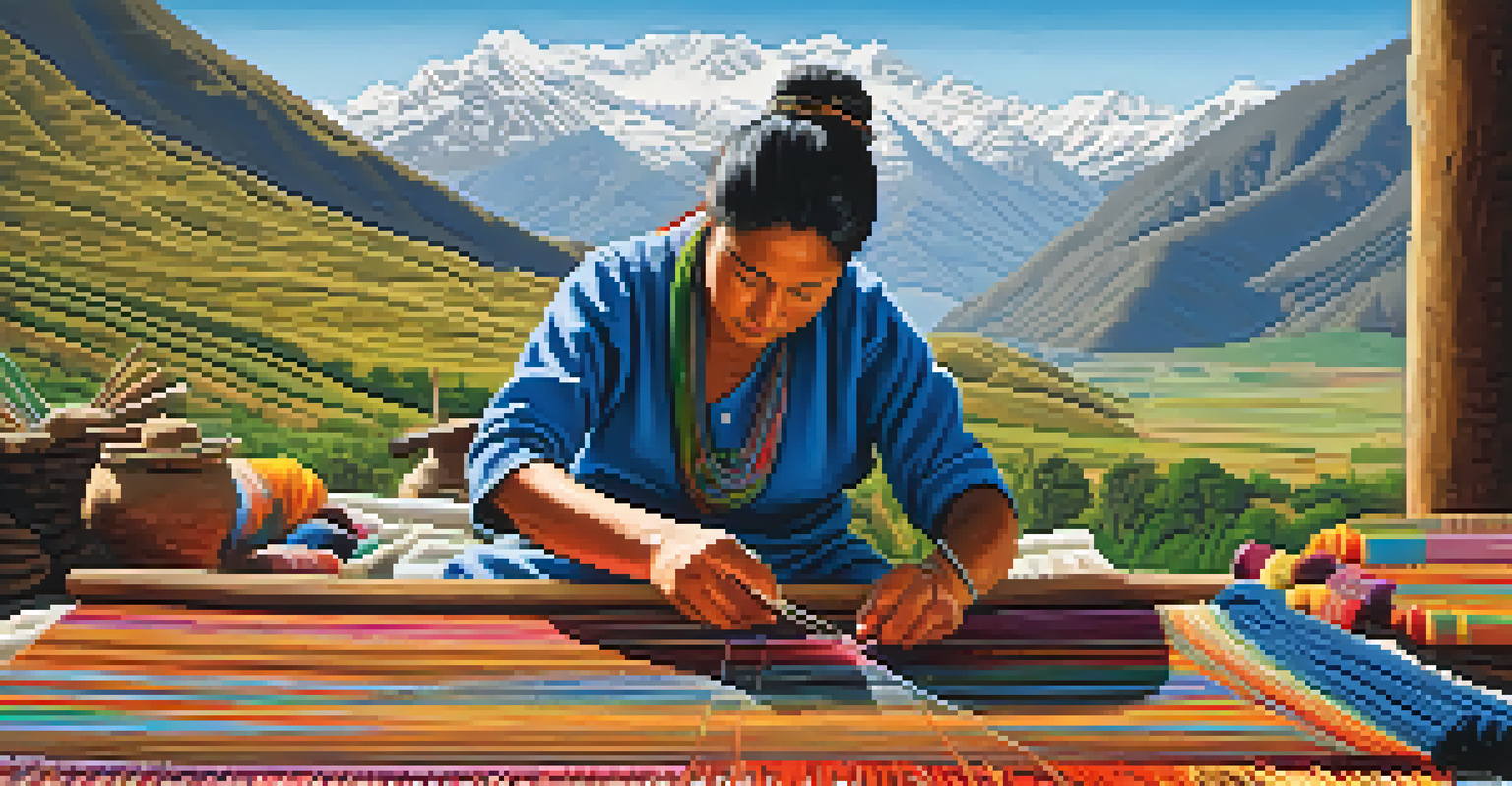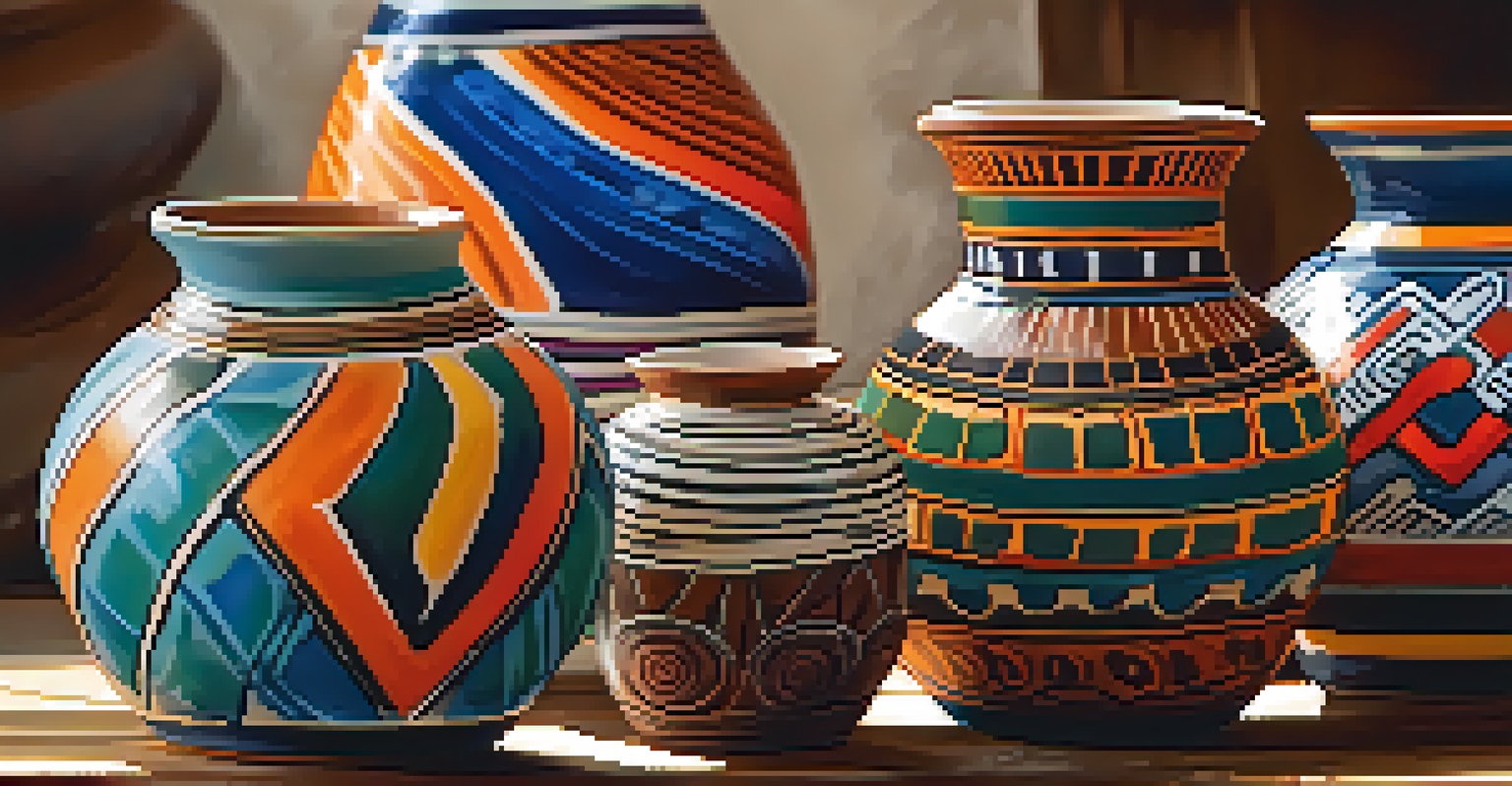Promoting Cultural Tourism Through Peruvian Artisan Crafts

Understanding Cultural Tourism in Peru
Cultural tourism focuses on experiencing a destination's way of life, including arts, traditions, and history. In Peru, this concept is rich and layered, offering visitors a chance to immerse themselves in the vibrant cultures of various regions. With its diverse heritage, Peru attracts tourists eager to learn about indigenous practices and local customs.
Traveling – it leaves you speechless, then turns you into a storyteller.
One of the most compelling aspects of cultural tourism is its ability to foster understanding and appreciation of different lifestyles. This goes beyond mere sightseeing; it invites travelers to engage with the local community. By exploring artisans' workshops or participating in traditional craft-making, tourists can forge authentic connections.
Moreover, cultural tourism has a significant impact on local economies by creating jobs and supporting small businesses. When tourists buy handmade crafts, they not only take home a piece of Peru but also contribute to the sustainability of these artisans and their communities.
The Role of Artisan Crafts in Cultural Identity
Peruvian artisan crafts are a reflection of the country's rich cultural identity, showcasing unique techniques and materials passed down through generations. Each piece tells a story, whether it's a colorful textile from the Andes or a beautifully crafted pottery piece from the coast. These crafts serve as a tangible link to Peru's history and traditions.

Artisans often incorporate local resources and traditional methods into their work, creating products that resonate with their cultural heritage. This not only preserves these age-old practices but also enriches the craft with authenticity. For tourists, purchasing these items becomes a way to take home a piece of Peru's vibrant culture.
Cultural Tourism Enriches Experiences
Cultural tourism in Peru allows travelers to engage deeply with local communities, enhancing their understanding and appreciation of diverse lifestyles.
Furthermore, supporting artisan crafts contributes to cultural preservation. As more travelers seek genuine experiences, the demand for these crafts can encourage younger generations to learn and maintain their ancestral skills, ensuring that these traditions endure.
Connecting Tourists with Local Artisans
Connecting tourists with local artisans is essential for promoting cultural tourism. Experiences such as workshops or guided tours provide travelers with an intimate understanding of the craft-making process. This connection enriches the tourist experience, making it more memorable and impactful.
The best way to find yourself is to lose yourself in the service of others.
Many organizations and tour operators are now focusing on responsible tourism practices that benefit local communities. By facilitating these connections, they help tourists appreciate the skill and effort required to create traditional crafts. This not only enhances the visitor's experience but also fosters respect for the artisans' work.
Additionally, these interactions can lead to storytelling opportunities, where artisans share their personal journeys and the significance behind their crafts. Such narratives deepen the appreciation for the art and the artist, transforming a simple purchase into a meaningful exchange.
Marketing Peruvian Artisan Crafts to Tourists
Effective marketing strategies are crucial for promoting Peruvian artisan crafts to potential tourists. Utilizing social media platforms, engaging visuals, and storytelling can showcase the beauty and significance of these crafts. Captivating content can draw attention to the artisans and their work, creating a buzz around cultural tourism.
Collaborating with influencers or travel bloggers can also amplify the reach of artisan crafts. Their genuine endorsements can inspire their followers to explore Peru and engage with local artisans. This word-of-mouth marketing can be a powerful tool in attracting tourists who value cultural experiences.
Artisan Crafts Preserve Heritage
Peruvian artisan crafts reflect the country's rich cultural identity and support the preservation of traditional techniques and skills.
Moreover, highlighting the uniqueness of Peruvian crafts in tourism campaigns can set these offerings apart from other destinations. By emphasizing their authenticity and the artisans' stories, tourists are more likely to feel a personal connection to the crafts and the culture they represent.
Sustainability in Artisan Craft Production
Sustainability is an increasingly important factor in the production of artisan crafts. Many Peruvian artisans prioritize environmentally friendly practices by using natural materials and traditional techniques. This not only preserves the environment but also enhances the value of their crafts.
By choosing sustainable methods, artisans ensure that their work contributes positively to their communities and ecosystems. This commitment can resonate with tourists who are conscious of their environmental impact and prefer to support businesses that align with their values.
Promoting sustainable artisan crafts can also attract a niche market of eco-conscious travelers. Highlighting the sustainable aspects of these crafts in marketing efforts can appeal to this demographic, encouraging them to explore and invest in these unique offerings.
Challenges Faced by Peruvian Artisans
Despite the rich cultural heritage and demand for artisan crafts, Peruvian artisans face numerous challenges. These include competition from mass-produced items that can overshadow the uniqueness of handmade crafts. As a result, many artisans struggle to maintain their livelihoods and preserve their craft.
Access to markets and resources can also be a significant hurdle. Many artisans lack the necessary tools and platforms to showcase their work effectively. This can limit their ability to reach potential buyers, ultimately impacting their income and the sustainability of their craft.
Sustainable Practices Matter
Many artisans in Peru prioritize sustainable methods, appealing to eco-conscious travelers while positively impacting their communities and ecosystems.
Moreover, raising awareness about the value of artisan crafts among tourists is crucial. Educating travelers on the differences between handmade and mass-produced items can foster a greater appreciation for the artisans' work and encourage them to support local crafts.
The Future of Cultural Tourism in Peru
The future of cultural tourism in Peru looks promising, especially as interest in authentic experiences continues to rise. As travelers seek deeper connections with the places they visit, artisan crafts will play a vital role in shaping their experiences. This trend bodes well for both artisans and the tourism industry.
By fostering collaborations between artisans and tourism stakeholders, Peru can create a more sustainable and enriching cultural tourism model. This can not only enhance the visibility of local crafts but also ensure that the benefits of tourism are equitably shared within communities.

Ultimately, promoting cultural tourism through Peruvian artisan crafts can lead to a more sustainable future. By valuing and investing in these unique offerings, we can preserve the cultural heritage of Peru while providing unforgettable experiences for travelers.